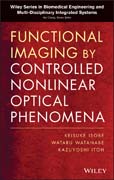
Functional Imaging by Controlled Nonlinear Optical Phenomena
Itoh, Kazuyoshi
Isobe, Keisuke
Watanabe, Wataru
Ultrafast lasers allow high–precision imaging and manipulation for biological and medical applications. Nonlinear optical microscopy has provided researchers with unique possibilities of three–dimensional imaging of biological cells and tissues. Nonlinear optical imaging technique is a rapidly emerging research area with widespread fundamental research and clinical applications. Nonlinear optical imaging allows both structural and functional imaging with cellular level resolution imaging in biological systems. The introduction of endogenous or exogenous probes can selectively enhance contrast for molecular targets in a living cell as well as supply functional information on processes. With the aim to control nonlinear optical processes and to obtain functional images, nonlinear optical processes can be controlled by photo–controlled probes and/or parameters of ultrafast laser pulses, such as time, space, polarization, and phase. This book gives an overview of the nonlinear optical process by ultrafast laser pulses and explains how the basics of nonlinear optical microscopy led to the most advanced techniques of photo–controlled nonlinear optical microscopy. INDICE: LIST OF FIGURES ix LIST OF TABLES xxi PREFACE xxiii ACKNOWLEDGMENTS xxv ACRONYMS xxvii 1 ULTRAFAST OPTICS FOR NONLINEAR OPTICAL MICROSCOPY 1 1.1 Nonlinear Optical Phenomena 1 1.1.1 Introduction to Nonlinear Optics 1 1.1.2 Second–Order Nonlinear Optical Phenomena 12 1.1.3 Third–Order Nonlinear Optical Phenomena 25 1.2 Nonlinear Ionization 54 1.2.1 Nonlinear Optical Ionization 54 1.2.2 Avalanche Ionization 55 1.2.3 PhotodisruptionOptical Breakdown 56 1.3 Light Source 58 1.3.1 Ultrashort Laser Pulse 58 1.3.2 Dispersion Management and Pulse Shaping 60 1.3.3 Pulse Characterization in Nonlinear Optical Microscope 72 1.3.4 Wavefront Compensation 78 References 80 2 BASIC MICROSCOPIC TECHNIQUE 87 2.1 Basic Architecture of a Laser Scanning Microscope 87 2.1.1 Scanning Methods 89 2.1.2 Signal Detection 90 2.2 Fluorescence Technique 91 2.2.1 Various Fluorescent Molecules and Multi–Color Fluorescence Imaging 91 2.2.2 Fluorescence Resonance Energy Transfer Imaging 101 2.2.3 Fluorescence Lifetime–Resolved Imaging 107 2.2.4 Fluorescence Recovery after Photobleaching Imaging 116 2.2.5 Fluorescence Correlation Spectroscopy 121 References 130 3 NONLINEAR OPTICAL SPECTROSCOPY (NLOS) 145 3.1 Laser–Wavelength Scanning Method 145 3.2 Multiplex Spectroscopy 149 3.2.1 Principle of Multiplex Nonlinear Optical Spectroscopy 150 3.2.2 Experimental Setup for Multiplex–NLOS 157 3.2.3 Measurement of Spectroscopic Information by Multiplex–NLOS 157 3.3 Fourier–Transform Spectroscopy 158 3.3.1 Principle of FT–NLOS 160 3.3.2 Experimental Setup for FT–NLOS 167 3.3.3 Measurement of Broadband Excitation Spectra by FT–NLOS 167 References 169 4 NONLINEAR OPTICAL MICROSCOPY 173 4.1 Introduction to Nonlinear Optical Microscopy 173 4.1.1 Various Nonlinear Optical Microscopies 173 4.1.2 Basic Architecture of a Nonlinear Optical Microscope 174 4.1.3 Spatial Resolution 176 4.2 Fluorescence Imaging 176 4.2.1 Basic Two–Photon Excited Fluorescence (TPEF) Microscopy 176 4.2.2 Application of TPEF Microscopy 184 4.2.3 High–Speed Imaging Using TPEF Microscopy 190 4.3 Electronic Resonance Imaging 204 4.3.1 Stimulated Parametric Emission Microscopy 204 4.3.2 Two–Photon Absorption Microscopy 211 4.4 Vibrational Imaging 214 4.4.1 Coherent Anti–Stokes Raman Scattering Microscopy 214 4.4.2 Stimulated Raman Scattering Microscopy 230 4.5 Second–Harmonic Generation Imaging 234 4.6 Refractive Index Imaging 244 4.6.1 Third–Harmonic Generation Microscopy 244 4.6.2 Nonresonant Four–Wave Mixing Microscopy 249 References 252 5 FUNCTIONAL IMAGING BASED ON MOLECULAR CONTROL 267 5.1 Localized Optical Marking and Tracking Using Photomodulatable Fluorescent Molecules 267 5.1.1 Photomodulatable Fluorescent Molecules 268 5.1.2 Imaging with Localized Optical Manipulation of Photosensitive Molecules 275 5.2 Multifarious Control of Multiphoton Excitation by Pulse–Shaping Technique 279 5.2.1 Control of Two–Photon Fluorescence in Multi–Labeled Sample 279 5.2.2 Control of Vibrational Mode Excitation by a Single Broadband Pulse 289 5.3 Super–Resolution Imaging Utilizing Nonlinear Response 298 5.3.1 Stimulated Depletion Emission Microscopy 299 5.3.2 Saturated Excitation Microscopy 303 5.3.3 Saturated Structured Illumination Microscopy 307 5.3.4 Single–Molecule Localization Microscopy 310 References 312 6 ULTRAFAST LASER SURGERY 327 6.1 Laser Cell Nanosurgery 327 6.1.1 Femtosecond Laser Surgery 327 6.1.2 Plasmonic–Enhanced Nanosurgery 335 6.2 Photodisruption and Photo–Stimulation 335 6.2.1 Photodisruption of Tissues 335 6.2.2 Laser–Induced Stimulation 336 References 336 INDEX 343
- ISBN: 978-1-118-09144-9
- Editorial: Wiley–Blackwell
- Encuadernacion: Cartoné
- Páginas: 368
- Fecha Publicación: 29/11/2013
- Nº Volúmenes: 1
- Idioma: Inglés
